In ancient Egyptian art, Ma’at (pronounced Muh-aht) may appear as a small kneeling figure or a large goddess with outspread or embracing wings. Her defining feature is a feathered headdress–just one upright feather. She’s first mentioned in the Pyramid Texts of Unas (ca. 2375 – 2345 BCE).
Our women’s mythology class studied Egyptian Goddesses for a few years before moving to other material. We recently returned to The Myth of the Goddess by Anne Baring and Jules Cashford for a second dip into ancient Egyptian tradition, symbolism, and art. This time, Ma’at captured my attention.
In ancient Egyptian ritual, the heart of the dead was weighed on a scales with Ma’at’s feather on the opposite side of the balance. If the heart was pure and as light as Ma’at’s feather, the person went to the afterlife. If the heart was heavy with misdeeds, it was devoured or cast into darkness, not unlike Christian images of hell.
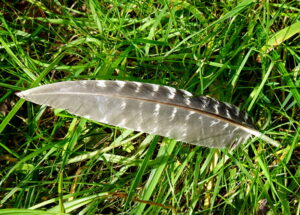 For me, Ma’at symbolizes a balanced social order focused on the heart. Egyptian civilization was theoretically built on her principles of justice, truth, and balance. Her image was common in tomb paintings and in The Egyptian Book of the Dead. Sometimes the Pharaoh held a doll sized statue of Ma’at in one hand as a symbol of her influence. Judges wore her emblem on their clothing.
For me, Ma’at symbolizes a balanced social order focused on the heart. Egyptian civilization was theoretically built on her principles of justice, truth, and balance. Her image was common in tomb paintings and in The Egyptian Book of the Dead. Sometimes the Pharaoh held a doll sized statue of Ma’at in one hand as a symbol of her influence. Judges wore her emblem on their clothing.
In Egyptian theology, the social order reflected the divine order, so Ma’at’s principles permeated all of life. I don’t know how well this worked in practice in ancient Egypt, but I love the symbolic significance in my own life. Each time I find a feather or receive a feather as a gift, I think of what I need to do to keep my heart light through kindness, generosity, care of the Earth and living beings, forgiveness, and gratitude.
I grieve over the injustices of our world and the unrelenting wounds inflicted on the Earth. I hope we’ll find new balance based on fairness and goodness, but did humans ever live with Balance and Justice? Maybe I’m naive, but the image of Ma’at with protective folded wings gives me hope.
***
As I pray for renewed trust and balance in the world, I also try to accept things as they are. I ask myself these questions, and I’d love to know your responses. What symbols support us? Where can we find a sense of balance and fairness? How can we establish truth and harmony in our culture and in ourselves?
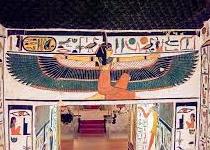
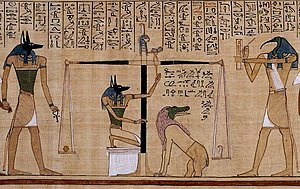
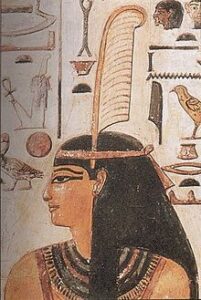
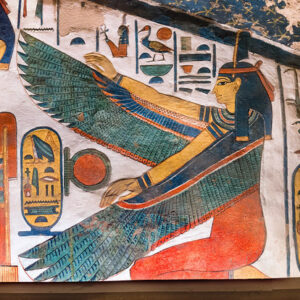
Dear Elaine,
Whether one is falling down from above or lying on the earth below, feathers fascinate don’t they! Oh, I love finding feathers too! Recently, I came across these meanings below when trying to understand the single black feather that landed on my writing chair which may tickle you when exploring colour feathers:
Purple: Prepare for a spiritual awakening
White: Your angel is watching over you
Brown: Good health and tranquillity
Grey: Peace and harmony are on their way
Black: You’ll feel better very soon (fingers crossed)
Blue: More spirituality in your life than ever
Yellow: Everything will be alright in the end
Orange: Your creativity will flow through
Pink: Love and happiness on the horizon
Red: Love and seduction are coming your way
Green: Luck will surely be on your side
Brown and white: Happiness is fast approaching
White and black: Hope and balance
Greenish red: Your finances are set to improve
Pigeon feather meaning: All is not lost, don’t give up
I wrote a poem about the Egyptian myth of Ma’at a few years ago, so know this wonderful story and its meaning of keeping one’s heart light. My answers to your questions are “the heart” is the best symbol for me, “in ourselves” and that takes lots of work “by studying Jung” is one answer and “exploring the myths” is another and my favourite is to “read the poets”. As always, your words, wisdom and shared insights are a joy to read and reflect on. Thank you, as always, for sharing your art and beautiful heart! Love and light, Deborah.
Dear Deborah, I found the feather pictured in the post when I took a walk on the day was working on this article. Black and tan? Black and white? Hope and balance. That works since it’s the focus of Ma’at. Thanks for your responses to my question. Read the poets! Is your poem about Ma’at in either of your books? I don’t remember seeing it, but I only focused on her recently so the reference wouldn’t have meant as much to me a few years ago. I agree about reading the poets, plus all wise spiritual teachers from every tradition and listening to wise trees. I’ve fallen in love with Ma’at as a Goddess and a principle. I want to find her in our out-of-balance world. With hope and gratitude and a little jealousy that your maples have red leaves and my early maple leaves turned brown and fell to the earth. There’s hope for a few late maples that didn’t get damaged by early infestations. Sending love.
Well, that got me searching through all my poetry books which I keep in the bedroom as I love to sleep and dream with the poets! Yes, Ma’at sort of stepped into my poem “In the Heart of the Woods” which starts on page 87 of “The Shepherd’s Daughter”. Wow, what synchronicity to find a feather on the very day you write a post about Ma’at! I love what Harriet says about this goddess holding a quiet strength.
We’re having strange weather here in the UK, one minute it’s freezing cold and the next it’s t-shirt and shorts weather. Occasionally we have snow during October so the trees seem to one minute speed up and the next slow down. Hopefully your unaffected late Maple Elders will also be wearing their beautiful red, yellow, green and gold autumn dresses soon.
Thanks, Deborah. I’ll look for it in the Shepherd’s Daughter. The feather was striking and in such perfect shape, lying on the grass right next to the trail. “Here. Take me. I’m yours.” Strong reds don’t look likely this year, but I look forward to seeing them next year. Gypsy moths did so much damage eating the canopy in the forest and the best way to stop them is a natural fungus that occurs when there’s lots of rain. So the fungus arrived and I hope the gypsy moths got a big setback and won’t be a problem next year, but the maples didn’t like getting more than twice the usual amount of rain and got a blight. Foresters tell me they’ll be fine next year, too, but there’s no doubt the forest is under stress and we’re still having early September temperatures. I think we’ll have to get used to weather extremes here and hope the trees can adjust. We need Ma’at!
I studied mythology but not Egyptian mythology per se. Thus, I’ve not heard of Ma’at and the symbolism associated with her.
Tonight I am heavy-hearted because of recent deaths and unwelcome health news about friends. Though I can’t attribute my heavy heart to misdeeds and malice, I’d miss the mark of Ma’at’s feather weight.
Thank you for a very informative post. I will ponder your questions, Elaine.
I don’t think you’d miss the mark, Marian. You have the kindest of hearts. It always strikes me as interesting when I find stories and virtues overlap from different traditions and I thought about the values taught by Jesus as I wrote this piece. A sad heart isn’t the same as one loaded with misdeeds and malice. I’m sorry about illness and death in your community. The same is happening in my community–illnesses that are fast and slow, ones that mark the end of life or long debilitation. Then there are the deaths and memorial services. This is the hard part of having strong links to others as we age, but I try to accept it as a spiritual teaching. Plus, when I get sad about my hearing loss, I can think of friends dealing with much harder issues. May all be well with you as we both struggle to accept that death is a natural part of life.
😀
Thank you for putting this out. It’s such a nourishing image to invoke of how things could be. Ma’at holds a quiet strength. I love her for that.
Thank you, Harriet. I love watching for Ma’at’s principles. She gives me hope.
I remember her from all the old days of admiring Egyptian art but never knew what she was about. Thank you for “introducing” her to me. I guess Ma’at is maybe my first symbol for all the things that I hold dear: kindness and generosity, caring, forgiveness and gratitude. There isn’t enough evidence of those in the world today if you are tuned in to the media. Wish I knew how goodness and balance and truth can be established. I look for those in little known places, in individuals who live quietly, peacefully.
You’re ahead of me, Robin. I hadn’t focused on her until recently despite studying other Egyptian Goddesses. Once I noticed, she’s universal and everywhere. And just to remind me, I found the feather lying next to the trail. I agree that her universal principles are hard to find in our larger world right now, but I see her in community and friendship. Having hearing problems keeps me one step removed from media, although I still read the news even if I don’t listen. I think we try to establish these principles in our own lives in small ways. So many of us are trying in a world that doesn’t seem supportive of these values. I’m reading ‘Braiding Sweetgrass’ for the second time and feeling a deep love for the Earth.
Thank you for introducing us to Ma’at Elaine. I recall her vaguely. There’s nothing vague about her though, she’s an impressive figure as are the principles she stands for. I love that the weight of a feather on the scales determines whether heaven or hell in the afterlife … a delicate balance. And her protective folding wings. I love finding feathers. They’re so delicate and pretty.
Susan, Anne Baring says Ma’at is both a Goddess and the ideal principles of Egyptian culture. Ideal was probably never realized, but now that I know more about Ma’at I see her small kneeling image in many Egyptian tomb paintings and find the images of her helpful in keeping my own sense of balance. I’d read about her in the past, but had never taken in her stories in a deep way. She seems essential in these unbalanced times. May all be well in your country and mine.
What a wonderful (issue, subject, literacy or knowledge) you have mentioned here, my dear wise friend. Oh yes, with the help of Goddess Ma’at to find the balance. It is the solution to a lot of problems if we just try to use it. I wished that in the other religions, there were a Goddess of balance like Ma’at. Have a great start to the new week.
PS: sorry for my belated comment. I (tried) to have a rest!
Thank you. I love imagining what Ma’at would do in my personal life. Now if we could only talk politicians and billionaires into considering Her values of truth and justice with a focus on the heart. I hope you got some rest. I’m behind on everything as usual but hope to do more reading tonight.
Hello Elaine,
I just tried to submit my response when my internet went offline. I’ll resubmit it in case it didn’t go through:
What an inspiring post, Elaine, and I, too, “love imagining what Ma’at would do in my personal life.” I recognize the image of Ma’at from what you posted, but I have never learned anything about her before. When you asked what symbols support us, I immediately thought of feathers. I have one tattoo – a feather (on the inside of my right arm). I have always loved feathers, and when my godfather was dying, I had a dream about sending him two feathers. Though it’s unusual for me to take my dreams literally, when I woke up, I picked two of my favorites from my “feather jar” and mailed them to him. From his response, it felt as though the feathers touched him with Ma’at’s protection and quiet strength.
I don’t have any easy answers to your last two questions, but I resonate with what you wrote, “I think of what I need to do to keep my heart light through kindness, generosity, care of the Earth and living beings, forgiveness, and gratitude.” I think of you and others who express such deep love for the earth. With gratitude, as always, Anne
Dear Anne,
So now you have another or more meaning for that feather. There are some images of Egyptian Queens with many Ma’at feathers decorating their bodies. I hadn’t known much about Ma’at until I read about her in Anne Baring’s book and discussed her with our mythology class. I’m glad I know more and now each feather I find has a deeper meaning and I take it as a sign. She’s everywhere in Egyptian tomb decorations because balance and justice make all the difference in what happens after death. I don’t have to “believe” in Ma’at in any formal way, but most religions speak of an underlying sense of justice. Sometimes Ma’at is connected to Sophia. Thank you for your kind words, Anne. I always feel lifted by your comments.
I hope you didn’t get too much damage in the huge storm in the Pacific Northwest. The rain keeps coming here and it’s unseasonably warm. I won’t complain because rainy trails are easier to navigate than snowy trails. Sending you warm gratitude. (I only got this one message, so the first was lost in the ethers along with many other internet messages.)